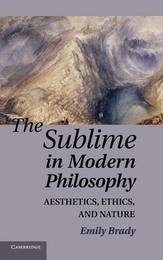
|
The Sublime in Modern Philosophy: Aesthetics, Ethics, and Nature
Hardback
Main Details
| Title |
The Sublime in Modern Philosophy: Aesthetics, Ethics, and Nature
|
| Authors and Contributors |
By (author) Emily Brady
|
| Physical Properties |
| Format:Hardback | | Pages:240 | | Dimensions(mm): Height 229,Width 152 |
|
| Category/Genre | Philosophy - aesthetics |
|---|
| ISBN/Barcode |
9780521194143
|
| Classifications | Dewey:111.85 |
|---|
| Audience | | Professional & Vocational | | Tertiary Education (US: College) | |
|---|
| Illustrations |
4 Halftones, unspecified; 4 Halftones, black and white
|
|
Publishing Details |
| Publisher |
Cambridge University Press
|
| Imprint |
Cambridge University Press
|
| Publication Date |
12 August 2013 |
| Publication Country |
United Kingdom
|
Description
In The Sublime in Modern Philosophy: Aesthetics, Ethics, and Nature, Emily Brady takes a fresh look at the sublime and shows why it endures as a meaningful concept in contemporary philosophy. In a reassessment of historical approaches, the first part of the book identifies the scope and value of the sublime in eighteenth-century philosophy (with a focus on Kant), nineteenth-century philosophy and Romanticism, and early wilderness aesthetics. The second part examines the sublime's contemporary significance through its relationship to the arts; its position with respect to other aesthetic categories involving mixed or negative emotions, such as tragedy; and its place in environmental aesthetics and ethics. Far from being an outmoded concept, Brady argues that the sublime is a distinctive aesthetic category which reveals an important, if sometimes challenging, aesthetic-moral relationship with the natural world.
Author Biography
Emily Brady is Reader in Aesthetics at the Institute of Geography and Environment, and an Academic Associate in Philosophy at the University of Edinburgh. Her research interests include environmental aesthetics (nature, art, cultural landscapes and everyday life), environmental ethics, Kant and eighteenth-century philosophy. Brady is author of Aesthetics of the Natural Environment (2003) and co-editor of Aesthetic Concepts: Essays after Sibley (2001), Humans in the Land: The Ethics and Aesthetics of the Cultural Landscape (2008) and Human-Environment Relations: Transformative Values in Theory and Practice (with Pauline Phemister, 2012). Brady has been a Laurance S. Rockefeller Faculty Fellow at Princeton University's Center for Human Values and is a past president of the International Society for Environmental Ethics. She has been an associate editor of Environmental Values and a co-editor of Society and Space and has also served as secretary, treasurer and executive committee member of the British Society of Aesthetics.
Reviews'... an ambitious, erudite, and impressive study of the history of the aesthetic category of the sublime that makes a strong case for the ongoing relevance of the sublime as an important aesthetic category in environmental aesthetics. It should be read by anyone seriously interested in the connections between aesthetics, ethics and nature.' Sandra Shapshay, Notre Dame Philosophical Reviews 'For those interested in an in-depth examination of the sublime over an extended period of time, pairing this volume with Timothy Costelloe's edited The Sublime would provide a nice overarching analysis. Summing up: recommended. Upper-division undergraduates and above.' Choice 'Owing to the quality of its scholarship, Brady's book is sure to be a standard reference. Those looking for a trustworthy one-stop shop on the sublime as historically conceived need look no farther. [The] concluding chapter is a welcome and edifying contribution to the literature that seeks to keep the past firmly alive for the present.' Christopher Williams, Journal of the History of Philosophy 'In this detailed, scholarly work Emily Brady seeks to renew the aesthetic concept of the sublime by clarifying its heritage and demonstrating its relevance to contemporary, environmental sensibilities.' Isis Brook, Environmental Values 'The book is a considerable achievement and an important one for those working in aesthetics or environmental philosophy. There is great insight here about a significant aesthetic experience and the light it sheds on the human relation to nature. Those interested in the historical development of the notion of the sublime should also pay attention to this book. Brady has made her case that the sublime deserves a prominent place in contemporary aesthetics and environmental thought.' Ned Hettinger, Environmental Ethics Journal
|